A conversation with comic artist, organizer and activist Johanna Rojola, written by Saskia Gullstrand.
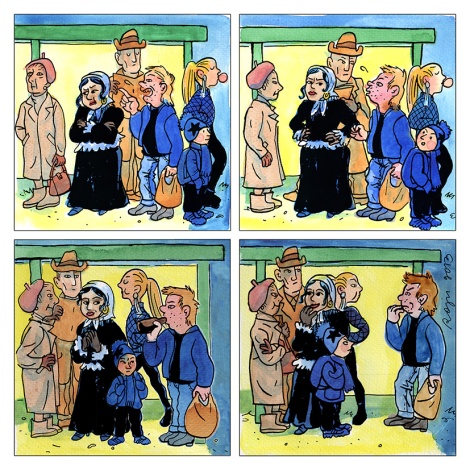
Comic by Johanna Rojola, that illustrates ways of racist behavior and how to address it, planned closely together with the Finnish Refugee Council 2013 & 2014.
I want to be a witch of the comics scene, because the comics community is a strange soup, and the witches add some boiling heat to it, stirring their spoons deep into art and structures, pushing for feminist change, workers’ rights and transforming comics storytelling as we know it. So I turn to Johanna Rojola. I believe she can teach me some tricks of the trade.
Johanna Rojola, or Roju for short, is a teacher, cultural producer and comic artist who’s been working in the comics communities of Finland and Europe for over 20 years. She is one of the founders of FEMSKT, the Finnish Feminist Network for Comic Artists, as well as one of the people who continue to take bold initiatives within the network, often reaching out to feminist comic artists abroad for international collaborations.
The first time I met her was in Villa Salin in Helsinki in 2013 at a residence for feminist comic artists that Roju was co-organizing. I came to the residence at an old, beautiful house by the sea, to finally meet some people involved in the Finnish comics scene. A week before, I had started a comics and graphic design programme at a Swedish-speaking community college, one hour from Helsinki. Most of my classmates had never done comics before, so I was longing to meet others who were deep in the heart of Finnish comics. Roju was there; we shared a meal together in a room full of paintings and traces from the Finnish women’s movement. I remember her sharp face, focused and tired, and in my memory, she’s constantly calculating: how many exciting ideas do we have, and how many hands are there that can do the work?
By invitation from FEMSKT, I went to Finland again in July 2016, to join Roju and others at the Saari residence near Turku, to work on an international research survey on discrimination, financial considerations and work conditions within comics. There, I was able to interview her about her work and dedication to change the system; to reshape the spider web where comic artists clamber around creating our stories and making our living.
Roju can teach me things, and I also believe that she has some useful stuff to share with you. I took the chance talk ask her about why she hates drawing, about her magnificently diverse work within the comics scene and the future of Finnish comics.
Let’s hear it in her words.
I NEVER HAD THAT FEAR
S: I’d like to start by asking “Who are you?”
R: Basic questions [laughs]. I’m Johanna Rojola. Usually people know me as my artist name Roju. I’ve been working in comics in Finland and abroad for twenty-something years. I got my first comic published by a small publisher Suuri Kurpitsa when I was 18; then I went to study comics in the art school in Angoulême. When I was around 20, I started working with the Finnish Comics Society as its president. That was the real beginning; I did not know that many things about the scene. I learned a lot from the other people that worked there. We organized the Helsinki Comics Festival, which was obviously much smaller back then. You couldn’t study cultural production when I was younger and I didn’t know that it existed as a profession. Otherwise I think that might have been my choice, instead of being an artist.
S: Do you also make your own comics nowadays, apart from teaching and organizing?
R: I hate drawing, to be honest, and I don’t really do it anymore. I lack the artistic calling and the patience. Also, drawing makes my whole body go stuck. You get so concentrated that you forget to move. And then when you get up, you are stiff and aching. I prefer moving. Producing and organizing suits my short attention span better these days; it gives me instant gratification. One thing I’m still interested in is screenprinting though. It’s kind of wild and very physical. You can’t completely control it.
S: When did you realize that you didn’t want to be an artist?
R: It has been a process for me… Since I was really little, the more or less unconscious thing about drawing was that I wanted to be so good at it so that I could draw anything I want. At some point, I kind of reached that, which is always really dangerous. That’s when you get “your style”, which I think is bullshit. More than anything, you should really be afraid of that. I started to think about why I wasn’t meeting deadlines anymore. Why was I avoiding drawing until the last minute and even past that? But I can still get to that flow with drawing where time, space and everything just disappear, where you are just so extremely concentrated. It’s like magic. I trust that I will always have this. Some people, those who are almost drawing compulsively, they can be afraid of losing their ability and never being able to do it again. I never had that fear.
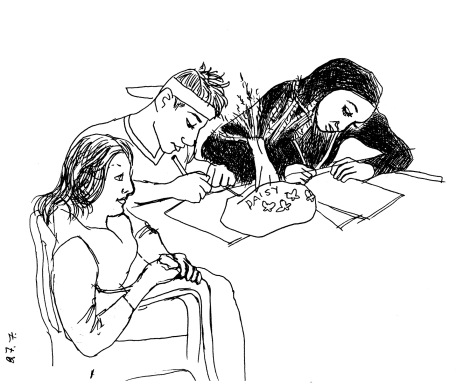
Sketch by Johanna Rojola.
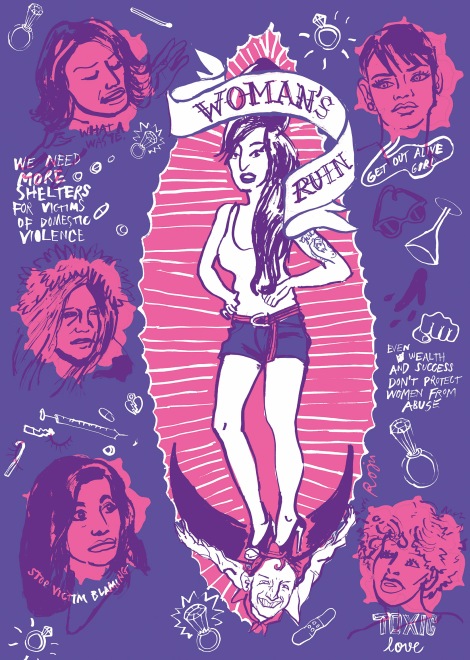
A woman’s ruin, silk screen poster for Kuti kuti Tempora mutantur exhibition, 2016. By Johanna Rojola.
S: I feel that people often refer to “finding your own style” in a very business-oriented way, like finding a trick to make a unique style that people will recognize as your trademark. But I think that style and the way the artist portrays things has to do with what they are interested in communicating about the world. What bothers them, what pleases them, all these different conscious or unconscious things. And I’m fascinated as to why some things keep reappearing in the image world of a person.
R: My thoughts on drawing are a little bit different. What I really love about is drawing what you see, because then you have the real-life three-dimensional world, and you, the artist, have to decide how to depict it with only two dimensions. This for me is the magic of drawing. When you draw from life and have to translate the 3D-world into 2D, something happens in your muscles, and something happens in your brain. It suddenly has more neurons in it. That’s why I still think that you have to do real-life studies to become an artist. It doesn’t matter if you manage to draw the model completely right; what matters is what happens in the head and the drawing arm.
S: I remember the shift when I started to see the world differently because of practising drawing like this, when I started to see shapes where I previously had not.
R: Yes, that’s it.
S: How do you relate to symbols, image worlds and storytelling? I mean… I’m interested in what things we use to show an emotion or a relationship in the story, the poetry or metaphors that we use. My characters tend to have a desire or fear in their movement, as if they are approaching or avoiding something. This is important in my comics. I always draw small panels that focus on hands, for example, where the only thing you see is a hand reaching, touching or grabbing, or pulling or doing something. I have this fascination with hands, because that’s how a person touches their surroundings and interacts with the world. What are your thoughts on these things?
R: I think I’m much more mechanical. What interests me is basically: what is the message that you want to get across? When you know this, then you can re-edit and think about what is the best way of telling the story this time. To make sure that the storytelling stays clear, even though there are poetic things in there. The level of symbolism is for someone else to find out about. I just want to tell the story in a way that is as clear as possible. Then you go and make whatever analysis you can out of it. Everyone makes their own interpretations.
S: But I also do what you just described because I learned storytelling through film and animation. As a film-maker, you need to decide: What are the best angles to shoot this scene from? Why is this scene looking like this? Why are the characters doing do this? Otherwise you’ll end up in the editing room with completely random material and you will not be able to edit the story that you wanted to tell in the first place.
R: That approach is exactly what most comic artists lack. It’s also the main focus when I teach storytelling, no matter if I have the students for a day, a week or a year. If you were my student, I would be like: “okay, since you already learned this, then you have the right to think about the interpretations. Otherwise I would be like: ”No! No! No! You need to learn how to tell a story with pictures before you can even start on anything else!” A lot of people end up with talking heads and explaining squares, because they don’t know how to do storytelling like this. Their comics are really boring and hard to read. There are so many things that you can show in the images, instead of telling them. Show, don’t tell.
TELLING A STORY WITH STICKER NOTES
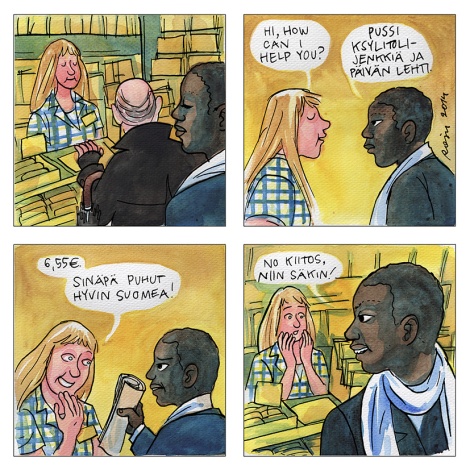
Comic from by Johanna Rojola. The kiosk vendor is being unintentionally racist by assuming that a non-white person doesn’t speak finnish. “Oh, you speak finnish very well!“ ”Thank you, so do you!” replies the guy.
S: Do you use film theory a lot as a comics teacher?
R: I have to, because we don’t have anything of our own. What I do actually is teaching how to tell a story with sticker notes, post-its. Because then you can edit it. The whole concept of editing comes from film. We don’t have a word for that in comics. In my class, we do a lot of group exercises, like group critiques of scripts, and everything is on post-its. Then you can easily try out different endings for example, because you can change the place of the two last pictures. Then the ending becomes totally different.
S: I love the idea of doing that within comic schools, to learn how to make a narrative.
R: I would do it also for my own longer stories. It works really well when you want to figure out how the scene is going to look, or what will be on a page because you can move the panels around. There are all these things you have to think about: like what panels do you want to have on the same double-page spread? Which panel should be last on the right-hand page of a double-page spread, so that you can use the surprise effect when the reader turns the page? Sticker notes are really good for that. You can get carried away and you make, I don’t know, 800 sticker notes! But I have even met a comics editor who said that: “We get proposals for a lot of books but they come as finished works and then we can’t do anything with them, because you can’t really edit comics.” That’s bullshit. What you need is to see the pencils. In any other art form, you’d first get a proposal of a script. But comics scripts shouldn’t be too written! I think the images have to be there from the beginning. Otherwise it will become illustrated writing. And that’s another thing that I see a lot, even professional comics artists basically illustrating their own text.
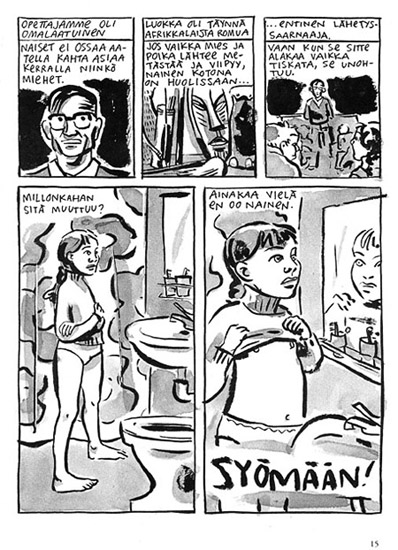
Page from Roju’s debut comic book Kapinapeitto (1997). Roju describes the page: ”My 5th grade teacher, a former missionary, saying that men and women are different. Boys and men can think about complex things whereas women might be worried but as soon as they start doing something, like washing dishes, they forget. /I’m eleven and wondering when do I become a woman, when will my capacity of thinking disappear.”
S: I’m getting so excited that we’re having this conversation! This is not at all what I planned for this conversation, but I’m so happy! [laughs]
R: I know! We would need a week to talk about everything! God, I love this. The big discussion that we still mostly lack in comics is about genre. Weirdly, comics have historically been classified by the way they have been printed. The traditional formats have been dictating what the content is. But since the 1980s we have been discussing and discovering what comics are and what we can actually do with comics. But the theory is going backwards.
S: What you explained about your sticker-note editing method reminds me of the spatial exhibition comics format* that I’m experimenting with in Underlandet at the moment. Comics are often exhibited in such a boring way in Sweden. You put up a printed page or an original in a frame on the wall as if it were a painting. Reading comics like that is so uncomfortable and horrible. What I do now instead is to make the comic directly for the room.
R: It’s like walking inside the panel.
S: Exactly. In a room, the body of the reader is always moving and this affects how the reader experiences the story, how well one can concentrate and so on. So you have to figure out how to make this movement correspond with the development of the story. The artist can include the movement of the reader in the experience as a storytelling tool, making the reading much more intense.
R: Making comics for a space has been done a lot in southern Europe. Have you been to Angoulême?
S: Never.
R: If you don’t go there, then you are going to do a lot of work for nothing because it has already been done. You should check out what Frémok have done. They have created these narrative spaces. Check them out!
YOU HAVE TO PAY THE BOOKSTORE TO GET YOUR BOOK ON THEIR SHELF.
S: The Finnish comics scene appears to be so much more international than its Swedish counterpart, always making international contacts. FEMSKT send a lot of invitations to us in Dotterbolaget, for example, to come over to Finland and participate in amazingly cool things.
R: I think the Finnish comic scene is really international on all levels. Maybe that’s the difference because of the size of the market. Swedish artists can’t live on whatever page rate Galago is paying, but you can always tell yourself that if you get published in their magazine, you will get by another month. In Finland we don’t have that possibility. An artist needs to do a lot of things in the beginning, without getting any money out of it. Then you may get a foreign publisher if you go to Angoulême for five years in a row.
S: So it’s really important for a Finnish comic artist to have an international network and get your comics published internationally?
R: Yes, you can never make a living here, never. If you want to live and work in Finland, you have to do several things: like producing, lettering, magazines and anthologies. You need to know how to ask for money and apply for grants. One person doesn’t have to do all of these things but you have to do more than one thing.
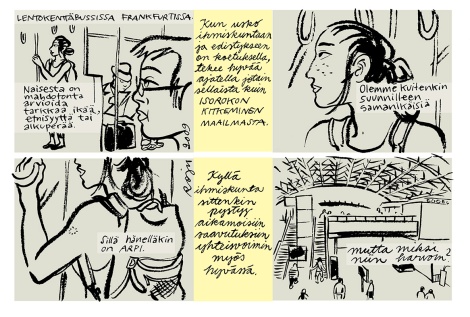
Comic by Johanna Rojola.
R: One really frustrating thing about the Finnish comic scene is that we still lack secure continuous funding. The structures within the scene are there but they are not funded. Any given moment, the whole thing can fall apart. It could happen because one person changes their job. It almost happened with the research project that FEMSKT are working on right now because I got my first real full-time job at 45 as a comics teacher. A woman like me, at 45-years-old, even if you have an academic background, you’re just a pariah, you won’t find any jobs. And this is my first real job. On top of that, I really like it. I still wake up every morning being like “How lucky I am!”. But it means that I don’t have time for anything else, including applying for money for this research project [on discrimination, financial considerations and work conditions within comics]. This year, Verna Kuutti did it, but she will stop after this residency. So I don’t know what is going to happen next. There is no continuity. And I know that this project is important; the statistics should come out. They do the same kind of research on film, but the difference between film and comics is that on the film side, it’s the state that is doing the research. And here we are, trying to get 4000 euros so that we can continue for a few more months.
S: Could you make a map for me of the main actors that you feel are important in the Finnish comics scene? Publishing houses, schools, the comics centre… What participants are there?
R: A map like this has been planned as a part of the research project that we’re doing now. It’s not done yet. I feel quite uncomfortable doing a map now because this needs more research and I want to do it more systematically. But maybe I can give you a structure of one part of the scene from my perspective… The Finnish Comics Society is the biggest thing, and I have been working closely with them. They run the Helsinki Comics Festival, the Helsinki Comics Center, do lobbying, organize international artists’ residences and many more things. But they don’t have their own money: they have to apply for funding and project money, from private and public foundations.
S: Who else would you put on the map, except for Finnish Comics Society? In Sweden, I would definitely include Galago, Kartago förlag, Kolik förlag, Syster förlag and many more publishers as important actors.
R: But do they do anything else for the artists than just publishing books?
S: Not necessarily, but to me it’s an invaluable part of the scene. Because without those publishers, artists wouldn’t have their books out there. Take Liv Strömqvist who is one of the main people behind the feminist comics boom in Sweden. I don’t think she would have had that success if Galago hadn’t have published her. Where would she have been published? By whom? And if people hadn’t have read her stuff…
R: But Galago is one of a kind. Then I would say that Kuti could be that, or the publisher Huuda Huuda.
S: But we also have Josefin Svenske, for example, who works with Kolik and Rabén&Sjögren. She edited a series of short stories by new and up-and-coming cartoonists called Grafiska novelletter. I did the last one before she quit working on that. Publishing this short story has been an enormous help to me because after that I was able to get grants. Any publishing house, even if they are motivated completely by sales, do something for their artists just by getting their books out. The books are extremely important to remain as a comic artist in Sweden because they are the key to future income.
R: That doesn’t work in Finland anymore.
S: Is that why it makes less sense for you to write down the names of the publishing houses?
R: Yes. Kuti do some important publishing work but they mainly publish art comics. Since 2000, people have been able to study comics in Finland. The majority of the students have been women. That began 16 years ago, so I’d say that the first comics graduates are in their thirties now. We should be in the middle of a renaissance of women’s comics. But not one of them has been published by a traditional publishing house. All the gatekeepers seem to be men. There aren’t that many publishers. They don’t do that much for the books. The ones that still get published are my age. The publishing houses might do one or two books with new people to try out, but there is no continuity. If the first book doesn’t sell, that’s it.
S: There are no second chances.
R: No, never. Young people are turning to the internet, and they go directly abroad. Like Hanna-Pirita Lehkonen, for example. We don’t have a mainstream market for printed comics in Finland. It’s partially because of the crisis of print everywhere, but it’s hitting a country like Finland harder, since it has a really limited market because of the language. Another thing, is that even before the crisis of printing, the distribution here sucks. We basically only have one chain of bookstores. And they don’t take any comics, really.
S: So it’s a monopoly situation.
R: Yes, with one buyer who doesn’t take any risks. You actually have to pay the bookstore to get your book on their shelf and get visibility. If you’re a new comic artist: first of all, you won’t get published. If you get a book published, the publisher won’t pay for the shelf spot in the bookstore. And we don’t have any public support for publishing.
S: None at all?
R: Translations, I think.
S: But nothing else?
R: I don’t think so.
S: That’s super interesting. In Sweden, we have the Swedish Art Council who support a number of books every year.
R: The most similar thing in Finland is this organisation that gives out a list of recommended books for the public libraries to buy. Comics got into that list, maybe, ten years ago. Every year, there are around 20 comic books that make it into the recommendation. The public libraries usually buy quite a lot of those. But I don’t know who makes those decisions because that’s not open-access information.
S: Yesterday you and I spoke about ways to publish when the established publishing houses and distribution chains don’t really work. The poetry scenes in Sweden and Finland can provide examples… In Sweden it seems like young poets don’t get published by anyone anymore because the smaller publishing houses that used to introduce new poets to the readers went bankrupt and disappeared, while the bigger publishers, like Bonniers, don’t really do this work. So poets born in the 1990s just don’t get their books out. If you are 30-years-old and unpublished, the risk of you quitting art is extremely high, because it’s hard to be a professional if you’re never made “official” by these structures. You told me yesterday that the Finnish poetry scene is self-publishing a lot now through collective initiatives. Could this be a way for the new generation of female comic artists in Finland and Sweden to get their first stuff out there, and to become “official”?
R: I don’t know the poetry scene super well, but I have some friends who are involved in it. They basically do self-publishing, but through the name of a collective or a co-op. What is important is what they have done on top of just publishing in book form… They do all kinds of events, like readings. That is an important part of how they organize themselves.
YOU HAVE TO WRITE YOUR OWN HISTORY
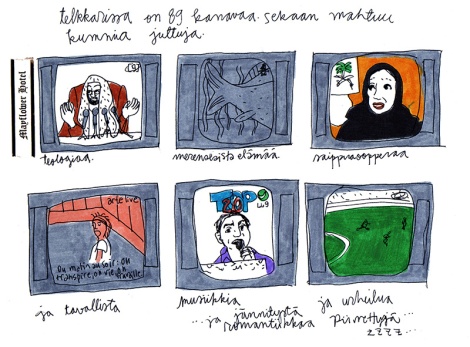
Drawings by Johanna Rojola, showing ”all the amazing tv channels I zapped at Mayfair Hotel, Beirut in 2005.” Roju was part of a World Comics workshop there with Beit Atfal Assumoud.[Read more here.]
R: I know! I quit updating my online CV because it became completely ridiculous: I can’t have so many things there, it doesn’t make sense. And I don’t feel like I have to prove anything for anyone anymore. But it’s a mistake because I should write it down. In feminist circles, we have been talking about how you have to write your own history. Because if you don’t… Firstly, if you don’t document things, we will end up by re-inventing the wheel over and over again. Secondly, it will only be the white guys’ history that survives.
.
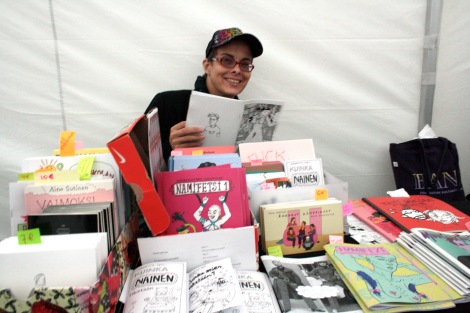
Johanna Rojola at the FEMSKT table of feminist comics, Helsinki Comics Festival 2016. Photo: Saskia Gullstrand
JOHANNA ROJOLA was born in Borås, Sweden, in 1970. She is a teacher, producer, activist, artist and more who studied comics at the European School of Visual Arts in Angoulême, France. She goes by the artist name Roju.
She has been involved in the Finnish and international comics communities for over 20 years, including holding comics workshops for World Comics Finland in Mozambique and being chairperson of the Finnish Comics Society. Roju is a member and co-founder of FEMSKT, a network for Finnish feminist comic artists, with whom she has organized several exhibitions, workshops, seminars and international feminist comic artist exchanges. As an activist, she focuses on themes like gender equality and social justice.
In 2016, she was made Comics Commissioner by the Finnish Comics Society, an award given every five years to someone who has significantly furthered the art form of comics.
